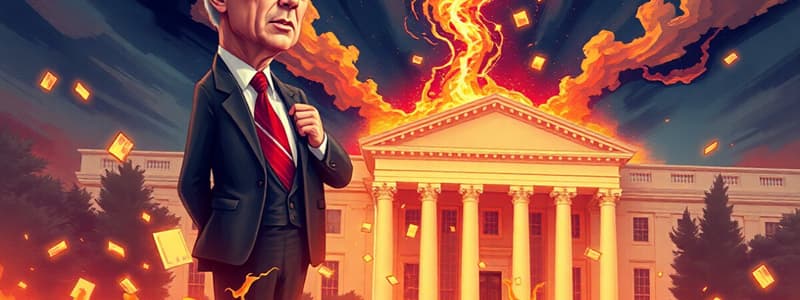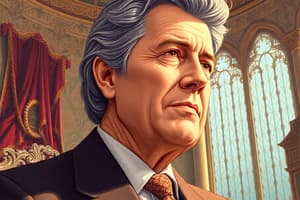Podcast
Questions and Answers
What was one of the main assumptions about Carter's presidency at the time of his election?
What was one of the main assumptions about Carter's presidency at the time of his election?
- He would focus on foreign relations.
- He would lower taxes significantly.
- He would end corruption from the Nixon years. (correct)
- He would increase military spending.
By how much did the number of dollars in the U.S. economy increase during the first two years of Carter's presidency?
By how much did the number of dollars in the U.S. economy increase during the first two years of Carter's presidency?
- 90 billion
- 55 billion (correct)
- 75 billion
- 10 billion
What was the price of gold approximately a year after Carter's election?
What was the price of gold approximately a year after Carter's election?
- $200
- $100
- $150 (correct)
- $250
What did the Carter administration's economic advisors think about the rising demand for gold?
What did the Carter administration's economic advisors think about the rising demand for gold?
What significant economic stage was the U.S. approaching by 1979?
What significant economic stage was the U.S. approaching by 1979?
What change in policy did the Federal Reserve implement in response to inflation concerns?
What change in policy did the Federal Reserve implement in response to inflation concerns?
What was the price of gold when the Carter administration took action to combat inflation?
What was the price of gold when the Carter administration took action to combat inflation?
Who did Carter ask to chair the Federal Reserve to help restore confidence in the dollar?
Who did Carter ask to chair the Federal Reserve to help restore confidence in the dollar?
What action was taken regarding Treasury gold sales during Carter's administration?
What action was taken regarding Treasury gold sales during Carter's administration?
What was the consequence of the Federal Reserve's new monetary policy?
What was the consequence of the Federal Reserve's new monetary policy?
What was the primary goal of the new monetary policy enacted by the Federal Reserve under Carter's administration?
What was the primary goal of the new monetary policy enacted by the Federal Reserve under Carter's administration?
What significant financial event indicated rising concerns about the U.S. economy during Carter's presidency?
What significant financial event indicated rising concerns about the U.S. economy during Carter's presidency?
What was a notable response from the Carter administration regarding the perception of gold?
What was a notable response from the Carter administration regarding the perception of gold?
What was a consequence of the Federal Reserve's change in policy regarding interest rates?
What was a consequence of the Federal Reserve's change in policy regarding interest rates?
Who was appointed by Carter to lead the Federal Reserve in order to address inflation issues?
Who was appointed by Carter to lead the Federal Reserve in order to address inflation issues?
Flashcards are hidden until you start studying
Study Notes
Carter's Presidency and Inflation
- James Earl Carter was elected president in 1976 with a promise to end corruption
- The Carter administration immediately began printing more money to finance its spending
- The money supply in the US grew by 55 billion dollars, or 18 percent
- Gold, a measure of inflation, rose from 100perounceatthetimeofCarter′selectionto100 per ounce at the time of Carter's election to 100perounceatthetimeofCarter′selectionto300 per ounce in 1979
Stages of Inflation
- The rising price of gold signaled that the US was entering stage two of inflation
- Stage three inflation could cause velocity to soar and trigger economic crisis, similar to what happened in France in the 1790s
Paul Volcker and the Federal Reserve
- Paul Volcker was appointed chairman of the Federal Reserve in 1979 to restore confidence in the dollar
- The Federal Reserve Open Market Committee decided to stop targeting interest rates and instead focus on tightly controlling money supply growth
- The US Treasury announced that it would sell gold from Fort Knox at random intervals and amounts in an attempt to decrease demand for gold
- These measures reduced the demand for gold and stabilized the economy
Inflation in the 1970s
- James Earl Carter was elected president in 1976 with the promise to curb corruption.
- The Carter administration increased the money supply in the US economy by 55 billion dollars in the first two years.
- This rapid inflation led to an increase in the price of gold from $100 per ounce to $150 per ounce in a year.
- The price of gold further rose to $ 200 per ounce in the following year.
- The Carter administration initially believed that the growing demand for gold was not a cause for concern.
- They believed that the money supply could be expanded without any negative consequences.
- The price of gold continued to rise reaching $300 in 1979, signifying a stage two inflation.
- This caused investors worldwide to lose confidence in the value of the dollar.
- As investors became increasingly nervous, there was a potential for a stage three inflation.
- At the time, gold was nearing $400 per ounce.
The Volcker Plan
- The Carter administration appointed Paul Volcker to chair the Federal Reserve in 1979.
- Volcker promised to restore confidence in the dollar.
- The Federal Reserve Open Market Committee decided to target money supply growth within specific limits.
- This meant that the Federal Reserve would focus on limiting the money supply growth and allow interest rates to fluctuate accordingly.
- The government also announced that Treasury gold would no longer be sold at regular intervals.
- The Treasury gold would be sold randomly, hoping to introduce uncertainty into gold ownership.
- These measures were designed to reduce the demand for gold.
- These policies successfully reduced the demand for gold and stabilized the dollar's value.
Studying That Suits You
Use AI to generate personalized quizzes and flashcards to suit your learning preferences.





